| |
Sampling Plans | Site Map |
| Main Areas:
|
| Software Area: |
Acceptance
Sampling:
|
| Acceptance Sampling of Bulk Liquids, Powders, Pellets | visitors= |
This example shows how to develop sampling plans for the mean and the range of measured properties of bulk liquids, powders, and pellets. Software program TP414 develops the sampling plans.
These acceptance sampling plans for the mean develop sample size(n), and the decision limits (A), for the sample average based your specification of two points on the operating characteristic (OC) curve. These plans have OC-curves which have the lot mean on the horizontal axis and probability of acceptance (Pa) on the vertical axis.
| Alpha Risk: | Producers risk of rejecting a "lot" when the true lot mean is equal to X=AQLMU or X=AQLML. |
| Beta Risk: | Consumers risk of accepting a "lot" when the true lot mean is equal to RQLML or RQLMU. |
For any oc-curve, TP414 provides three matched decision rules :
| Fixed-n | The sample size, n, is fixed at a constant value. |
| SPR sequential | n is determined by the data sequentially. Smaller average n per lot (ASN) than the matched fixed-n plan |
| TSS sequential | Similar to SPR sequential. Has advantages over SPR. |
To develop a sampling plan for the mean, you must provide a known historical within-lot
standard deviation (sigma). In addition to developing an acceptance plan for the mean,
TP414 provides a decision rule for testing that the standard deviation of the current
sampled lot has not changed significantly. This test is uses the range of the sample.
Topic |
|
| Software Program TP414 | |
| Fixed-n Decision Rule for the Mean | |
| Decision Rule to Check "known" standard deviation | |
| Graph of OC-Curve for the Mean | |
| Table of OC, ASN, and ARL-Curve for the Mean | |
| SPR Sequential Decision-Rule Diagram | |
| SPR Sequential Decision-Rule Table | |
| TSS Sequential Decision-Rule Table | |
| How to Order the Software |
Other Documents Available from H & H Servicco Corp.
| TP414 product description | (Software details) |
| Product Acceptance Design Journey | (How to apply) |
| Modern Acceptance Sampling | (Two-point methodology) |
Sections of the output reports:
(1) A user-controlled title
(2) Description of the statistical type of sampling plan.
(3) Two user-defined points on the oc-curve:
(4) Decision rule
(5) Date and name of program that produced the sampling plan.
Fixed-n Decision Rule for the Mean

Decision Rule to check Known Standard Deviation using the Range

Table of OC-Curve, ASN-Curve and ARL Curve for the Mean
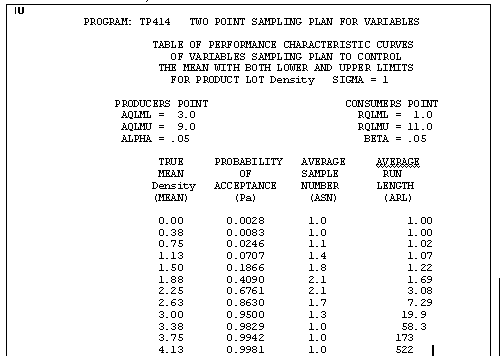
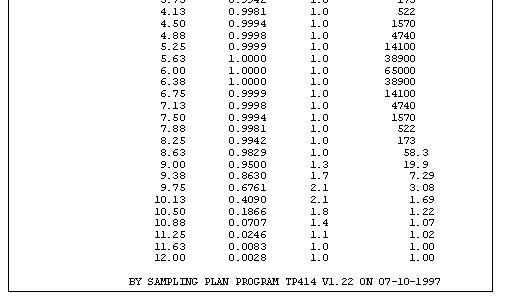
The OC-Curve above shows the probability of accepting(column 2) a lot as a function of the lot mean(Column 1). You use it to determine how well the acceptance plan will discriminate between lots having various true means.
The ASN curve shows the Average Sample Number (ASN) to reach a decision with a sequential plan. The ARL curve shows the number of lot decisions between rejections.
Graph of OC-Curve for the Mean
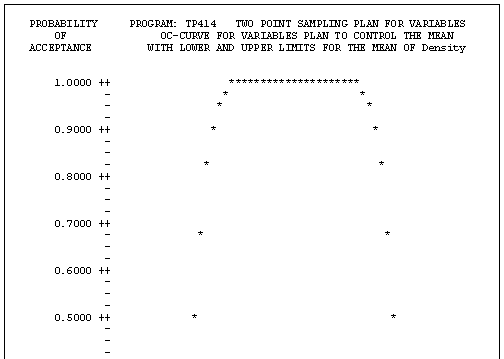
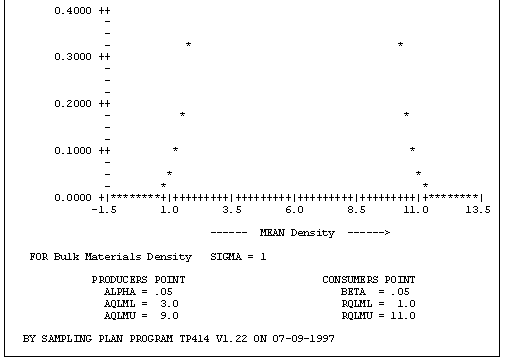
Sequential
Sampling
Sequential sampling is the leading methodology to
reduce the cost of inspection through reduced testing. Compared to fixed-n plans,
sequentials require fewer sample/tests, on average, than is possible with fixed-n plans
having the same risks.
SPR Sequential Decision Rule Table

The acceptance decision is made by considering the sample data sequentially, either one at a time or in groups. After each such increase in n, you compare the sample average to the Ac and Re that apply for that n. This determines whether you accept, reject, or continue to build up the sample.
Interface with Microsoft
Office
TP414 will export the decision rule table or an oc-curve
table to an ASCII file, making it readable by most commercially available graphics
software. The example below -- from a different sampling plan example -- was drawn by this
method using Microsoft's Excel.
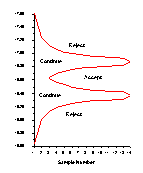
SPR Sequential Decision Rule Diagram
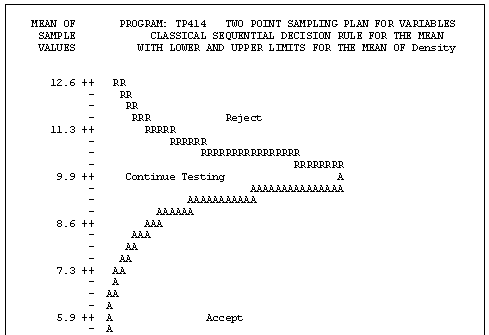
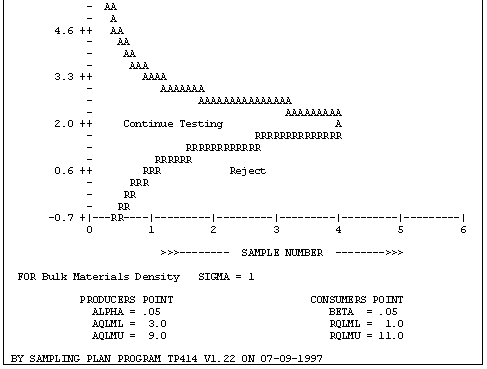
TSS Sequential Decision-Rule Table

This TSS Sequential decision rule operates the same way as the previous SPR sequential. The sample data is examined sequentially until the its average falls out of the continue zone and falls in either the accept zone or the reject zone.
A special property of the TSS type of sequential sampling plan is that the last line of the decision table, contains the n and ac of the fixed-n plan that it is matched to.
If you simulate the operation of a TSS plan, you will find that its OC-curve matches exactly with that of this matched fixed-n plan.
Summary of TP414 applied to bulk liquids, powders, and pellets:
We have refined this software over many years of use in these areas:
At just $245, TP414 will inexpensively
streamline your company's product acceptance methodology.
See additional information on how to order TP414